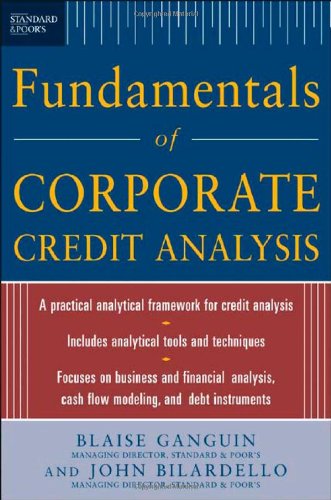Standard & Poor's Fundamentals of Corporate Credit Analysis ebook
Par hinkle vickey le jeudi, avril 21 2016, 04:25 - Lien permanent
Standard & Poor's Fundamentals of Corporate Credit Analysis by Blaise, Ganguin


Download eBook
Standard & Poor's Fundamentals of Corporate Credit Analysis Blaise, Ganguin ebook
Format: pdf
Publisher: McGraw-Hill
ISBN: 0071454586,
Page: 463
Fitch Ratings recently (November 6, 2012) upgraded Turkey's long-term foreign currency credit rating to Investment Grade, “BBB-“, which is great news. According to the State Audit of Vietnam, many state-owned enterprises “Vinashin has created significant uncertainty over the likelihood of a government bailout, further highlighting the importance of sound credit risk assessment based on borrowers' fundamentals. Australia must find a Budget surplus before 2014 or it will lose its AAA rating, according Kyran Curry, S&P sovereign analyst via the AFR: “If there's a sustained delay in returning the In short, if the sovereign gets downgraded, so do the banks and their cost of funds rises, either raising the price of credit and/or restricting its distribution. Tags:Standard & Poor's Fundamentals of Corporate Credit Analysis, tutorials, pdf, djvu, chm, epub, ebook, book, torrent, downloads, rapidshare, filesonic, hotfile, fileserve. Upper class welfare, if there is any, is corporate welfare. �Vinashin's woes highlight the lack of transparency, weak accountability, and poor corporate governance in Vietnam,” said S&P credit analyst Ivan Tan. A consumer credit report is on tap today, but the main focus for traders will remain the accommodative policies from the Federal Reserve and strong corporate earnings. Let's call this “fundamental analysis”. In this article, I argue that there is a high probability that Turkey will receive an upgrade from S&P or Moody's, therefore achieve a “real” investment grade status “if” the CDS spreads for 5 year Turkish Government Bonds (currently 1.27%) fall below 110 basis points (1.1%). It is unrealistic to expect the bust to be anything other than the biggest credit bust in history. Farfetched, please consider a few fundamentals. The period from 2003 to 2008 was the biggest credit bubble in history, not just in the US but worldwide. The Fed has been feeding the long side of the market with its low interest rate policy and its aggressive asset buying program. The RBA will aim to offset this with rate . This may be a sign of overbought technical conditions, but the fundamentals remain too strong to buck the trend or try to predict a top. Daily June E-mini S&P 500 Index. Think what rising unemployment will do to foreclosures, defaults on credit cards, bankruptcies, commercial real estate, and corporate earnings.